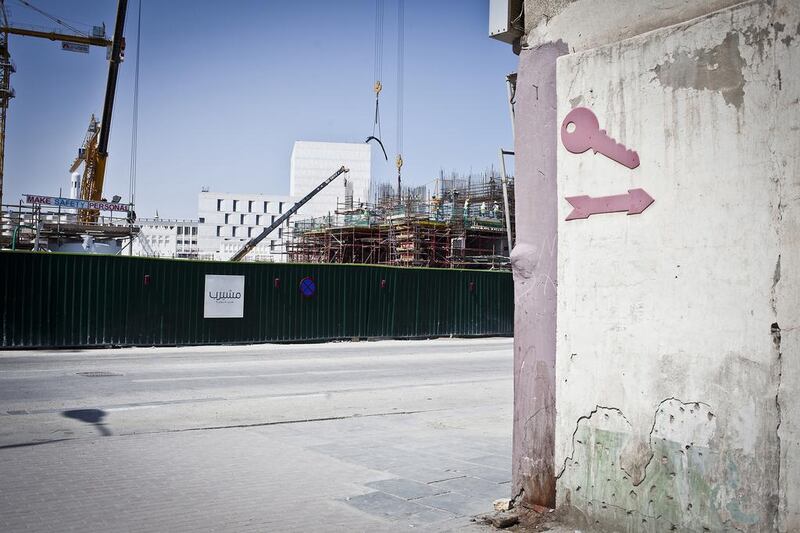DOHA // Across the street from the restaurant where Padam Raj has worked for seven years, workers are laying the foundations of what will ultimately spell the end of this South Asian eatery and its faded surroundings.
For the roughly 8,000 residents of Msheirib, once the commercial heart of Qatar’s booming capital, the construction marks an end of an era.
“Soon, this will be all gone. Flattened,” said Mr Raj, a waiter at the Golden Fork restaurant.
New building in the neighbourhood has been under way for several years on a mammoth urban development project called Msheirib Downtown.
The US$5.4 billion (Dh19.8bn) development promises to transform the area and its soot-caked collection of concrete, decades-old buildings that increasingly contrast with the city’s ultra-modern skyline.
Planned to cover 31 hectares when finished, the project includes high-end residences and shopping, cultural centres and government buildings. It is but one of many ambitious developments that Qatar hopes to complete by the time it hosts the football World Cup in 2022.
For the Golden Fork and other businesses in Msheirib, the development means being levelled to make way for modern promenades and apartment complexes. For residents of this low-income area of largely Asian workers, who will be forced eventually to leave, there is a feeling that part of Qatar’s heart and soul will be bulldozed along with their apartment buildings and businesses.
“This used to be the centre of Doha,” said Mr Raj, 26, a native of Nepal. “This used to be Doha.”
Three decades ago, Msheirib and its South Asian merchants were the commercial centre of a sleepier Doha. Some of the first international hotel chains in the capital opened here, and residents used to shop at furniture shops and mini-shopping centres here that have been overtaken by newly built and glitzy mega-malls springing up elsewhere in the city.
The working-class community of largely South Asian and Filipino men still carries the quaint if somewhat gritty charm of other melting-pot areas in the Gulf, such as Dubai’s Deira neighbourhood.
Hole-in-the-wall cafes sell delectable Pakistani sweets at dirt-cheap prices. Shops sell Bollywood blockbusters and mannequins sporting brightly coloured saris and chic sunglasses stand in shop windows. At night, the throngs of people packing the streets resemble the congested thoroughfares of Mumbai or Delhi.
To Jaya Narayan’s mind, this shows Msheirib still has plenty of heart.
The Nepalese shop assistant believes area also has a social cohesion that is lacking in new developments such the West Bay area, eight kilometres north, that is popular among Qataris and wealthy western expatriates.
“We are a community here. Indians, Filipinos, we’re all friends,” said Mr Narayan, 38.
As he spoke, a group of Bangladeshis, Pakistanis and Indians wearing traditional loose-fitting shirts and trousers or blue-and-yellow work overalls left a nearby mosque after Friday prayers. Some walked while holding hands. Others laughed, exchanging jokes.
“We don’t want to leave. We like it here,” said Mr Narayan as a dozen Nepalese men entered his City Style shop, which sells shirts and trousers for roughly Dh20 a piece.
As in other Arab Gulf countries, South Asians have been trading and working in Qatar since the days of the British Empire. Their cultural effect is still noticeable among the older generation of Qataris who speak Urdu and a smattering of other South Asian languages.
The remaining residents of Msheirib are not certain when the next demolition phase will begin. They said hundreds of employees of businesses that were knocked down in the initial phase of Msheirib Downtown’s construction have either moved to labour camps and low-income communities far outside of the city or left the country.
“Where will we go when this is gone?” said Mutamid Alam, 25, a Nepalese doorman at the area’s Al Nakheel Hotel.
The newer areas where workers like him are finding jobs are much farther away from areas of entertainment in the city.
Some will make the move to communities on the outskirts of Doha where their Qatari sponsors – who employ them and either own all or part of their enterprises – have set up new housing and businesses.
But not Mr Raj. When the Golden Fork is knocked down, he says, he will either look for work elsewhere in the Gulf or return to Nepal.
“The salaries for us are already too small,” he said, referring to his $275 monthly paycheck.
“I’m leaving.”
hnaylor@thenational.ae





